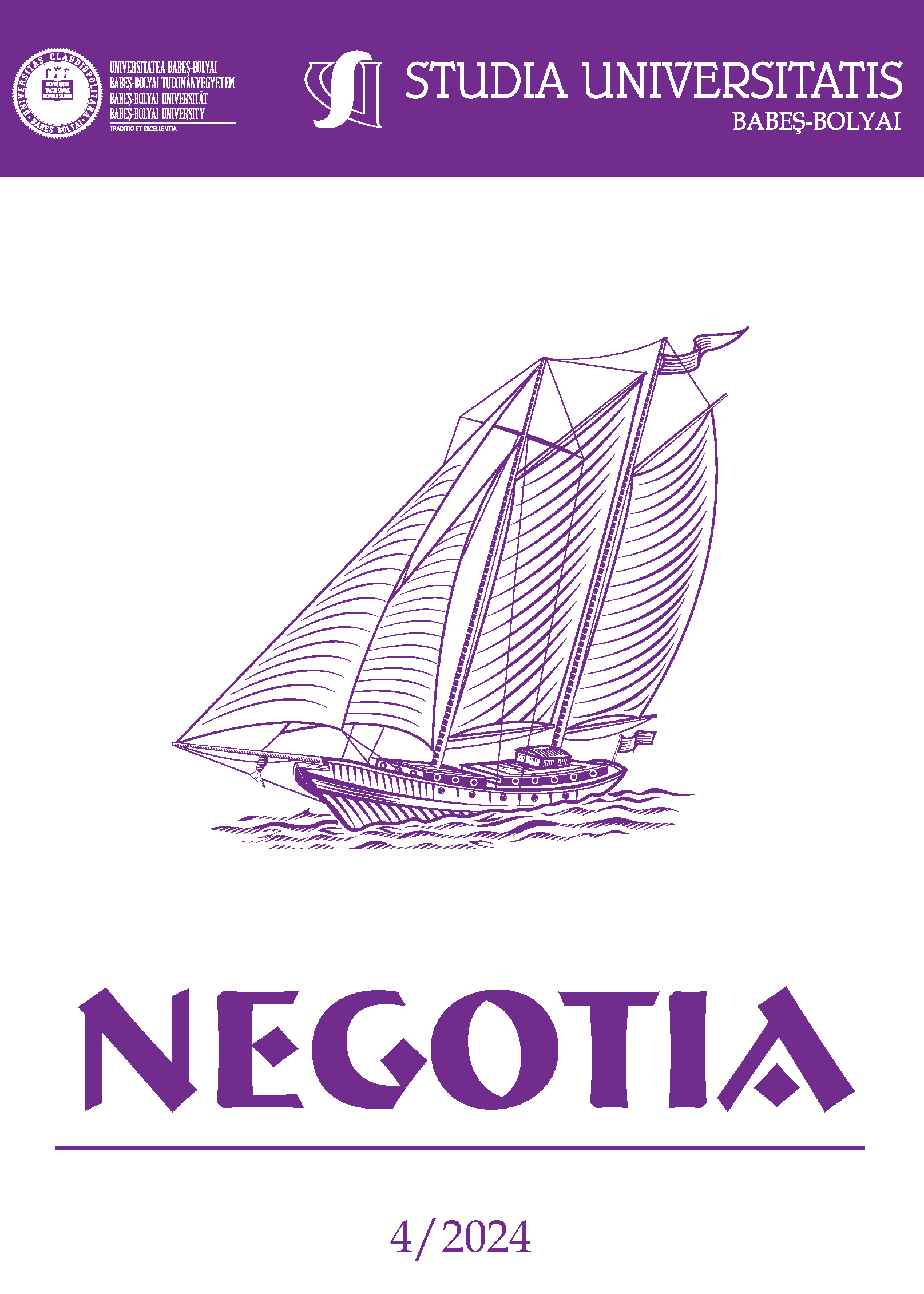Economic Tremors From a Perfect Storm: The Ukrainian Crisis and Its Impact on Regional Stock Market Volatility
DOI:
https://doi.org/10.24193/subbnegotia.2024.4.03Keywords:
Stock market volatility, geopolitical risk, Russia-Ukraine war, range-based volatility estimators, proximity effectAbstract
This study investigates the impact of the Russia-Ukraine war on stock market volatility in neighboring countries, analyzing five stock market indices (BET, BUX, WIG, SAX, and MOEX) over a three-year period encompassing one year before and two years after the conflict’s outbreak. Employing four volatility estimators (Close-to-Close, Parkinson, Garman-Klass, and Rogers-Satchell), this research examines the evolution of market volatility and inter-market correlations. Findings reveal a general increase in volatility across most indices following the war’s commencement, with the MOEX index experiencing the highest turbulence. The concept of a “proximity penalty” is partially supported, as geographical closeness to the conflict zone does not uniformly correspond to increased volatility. Also, findings show an initial strengthening of correlations between markets in the first year of the war, suggesting a “contagion effect.” However, this is followed by a weakening of correlations in the second year, indicating a potential “decoupling effect” as markets begin to respond more to local economic conditions. These results have significant implications for investors, policymakers, and risk managers, highlighting the need for dynamic portfolio management strategies, tailored policy responses, and flexible risk models that can adapt to changing market conditions during prolonged geopolitical crises. This study contributes to the existing literature by extending the temporal scope of analysis beyond the immediate aftermath of the war’s outbreak and providing insights into the “proximity effect” in the context of a major European conflict. The observed patterns of initial volatility spikes followed by varying degrees of persistence and changing correlation structures offer a nuanced picture of how geopolitical events impact financial markets over time, emphasizing the complex interplay between political events and financial market dynamics.
JEL classification: G15, F51
Article History: Received: October 14, 2024; Reviewed: November 27, 2024;
Accepted: December 2, 2024; Available online: December 17, 2024.
References
Adekoya, O. B., Oliyide, J. A., Yaya, O. S. & Al-Faryan M.A.S. (2022). Does oil connect differently with prominent assets during war? Analysis of intra-day data during the Russia-Ukraine saga, Resources Policy, 77, 102728. https://doi.org/10.1016/j.resourpol.2022.102728
Alizadeh, S., Brandt, M. W. & Diebold, F. X. (2002). Range-based estimation of stochastic volatility models, The Journal of Finance, 57 (3), 1047-1091. https://doi.org/10.1111/1540-6261.00454
Antonakakis, N., Gupta, R., Kollias, C. & Papadamou, S. (2017). Geopolitical risks and the oil-stock nexus over 1899–2016, Finance Research Letters, 23, 165-173. https://doi.org/10.1016/j.frl.2017.07.017
Boubaker, S., Goodell, J. W., Pandey, D. K. & Kumari, V. (2022). Heterogeneous impacts of wars on global equity markets: Evidence from the invasion of Ukraine, Finance Research Letters, 48, 102934. https://doi.org/10.1016/j.frl.2022.102934
Caldara, D. & Iacoviello, M. (2022). Measuring geopolitical risk, American Economic Review, 112 (4), 1194-1225. https://doi.org/10.1257/aer.20191823
Chan, L. & Lien, D. (2003). Using high, low, open, and closing prices to estimate the effects of cash settlement on futures prices, International Review of Financial Analysis, 12 (1), 35-47. https://doi.org/10.1016/S1057-5219(02)00125-4
Corbet, S., Gurdgiev, C. & Meegan, A. (2018). Long-term stock market volatility and the influence of terrorist attacks in Europe, The Quarterly Review of Economics and Finance, 68, 118-131. https://doi.org/10.1016/j.qref.2017.11.012
Federle, J., Meier, A., Müller, G. J. & Sehn, V. (2022). „Proximity to war: The stock market response to the Russian invasion of Ukraine”, CEPR Discussion Paper No. DP17185. Available at: https://papers.ssrn.com/sol3/papers.cfm?abstract_id=4060222
Floros, C. (2009). Modelling volatility using high, low, open and closing prices: evidence from four S&P indices, International Research Journal of Finance and Economics, 28, 198-206. Available at https://core.ac.uk/download/pdf/52391988.pdf
Garman, M. B. & Klass, M. J. (1980). On the estimation of security price volatilities from historical data, Journal of Business, 53 (1), 67-78. Available at: https://www.jstor.org/stable/2352358
Hudson, R. & Urquhart, A. (2015). War and stock markets: The effect of World War Two on the British stock market, International Review of Financial Analysis, 40, 166-177. https://doi.org/10.1016/j.irfa.2015.05.015
Liadze, I., Macchiarelli, C., Mortimer-Lee, P. & Juanino, P. S. (2022). The economic costs of the Russia-Ukraine conflict, National Institute of Economic and Social Research Policy Paper, 32, 1-13. https://doi.org/10.1111/twec.13336
Martins, A.M., Correia, P. & Gouveia, R. (2023a). The impact of the Russia–Ukraine war on the world’s largest listed insurance firms, The Geneva Papers on Risk and Insurance - Issues and Practice, 49, 779-803.
https://doi.org/10.1057/s41288-023-00305-w.
Martins, A.M., Correia, P. & Cro, S. (2023b). Stock market reaction to the military conflict between Russia and Ukraine: an event study for the European tourism and hospitality industry, Journal of Applied Economics, 26 (1), 2261756. https://doi.org/10.1080/15140326.2023.2261756.
Omar, A. M. A., Wisniewski, T. P. & Nolte, S. (2017). Diversifying away the risk of war and cross-border political crisis, Energy Economics, 64, 494-510. https://doi.org/10.1016/j.eneco.2016.02.015
Parkinson, M. (1980). The extreme value method for estimating the variance of the rate of return, Journal of Business, 53 (1), 61-65. Available at: https://www.jstor.org/stable/2352357
Rogers, L. C. G. & Satchell, S. E. (1991). Estimating variance from high, low and closing prices, The Annals of Applied Probability, 1 (4), 504-512. Available at: https://www.jstor.org/stable/2959703
Rogers, L. C. G., Satchell, S. E. & Yoon, Y. (1994). Estimating the volatility of stock prices: a comparison of methods that use high and low prices, Applied Financial Economics, 4 (3), 241-247. https://doi.org/10.1080/758526905
Wang, Y., Bouri, E., Fareed, Z. & Dai, Y. (2022). Geopolitical risk and the systemic risk in the commodity markets under the war in Ukraine, Finance Research Letters, 49, 103066. https://doi.org/10.1016/j.frl.2022.103066.
Yousaf, I., Patel, R. & Yarovaya, L. (2022). The reaction of G20+ stock markets to the Russia–Ukraine conflict “black-swan” event: Evidence from event study approach, Journal of Behavioral and Experimental Finance, 35, 100723. https://doi.org/10.1016/j.jbef.2022.100723
Downloads
Published
How to Cite
Issue
Section
License
Copyright (c) 2024 Studia Universitatis Babeș-Bolyai Negotia

This work is licensed under a Creative Commons Attribution-NonCommercial-NoDerivatives 4.0 International License.



